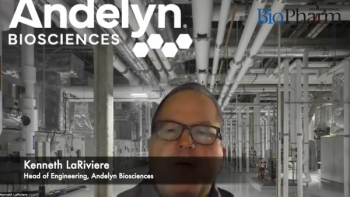
BioPharm International spoke with Kenneth LaRiviere, head of Engineering at Andelyn Biosciences, about the possible problems that can arise when operating an older facility for biopharmaceutical manufacturing.

BioPharm International spoke with Kenneth LaRiviere, head of Engineering at Andelyn Biosciences, about the possible problems that can arise when operating an older facility for biopharmaceutical manufacturing.

The importance of proper analysis of HCPs in the biomanufacturing process was discussed by Shawn Li, principal scientist at Merck & Co., known as MSD outside the Unites States and Canada, at AAPS PharmSci 360.

Pfizer’s bivalent RSV prefusion F vaccine has been approved by FDA to prevent lower respiratory tract disease resulting from the respiratory syncytial virus in adults 18 to 59 years of age who are at increased risk.

The agency’s CHMP recommended drugs to treatments for hemophilia, two biosimilars for psoriasis, and two flu vaccines at their October meeting.

The draft joint network strategy for the EU until 2028 will be open for public consultation until Nov. 30, 2024.

Aseptic fill/finish of biopharmaceuticals requires an understanding of the structure and limitations of each molecule.

In this article, the authors explored the elimination of a water rinse and blow down following the caustic wash step, examining potential safety considerations, the effect on the quality of the cleaning process, and the potential benefit of implementing this change.

This year's CPHI award winners emphasize achievements in pharma excellence.

At CPHI Milan, Zaim Gashi, area sales manager of Steriline, discussed the evolution of aseptic processing equipment to stay compliant with current regulations.

The agency is working with the European medicines regulatory network to improve the assessment and approval process for new medications.

Contract organizations offer assistance for testing raw materials obtained from outside suppliers.

There is potential to effectively marry the best aspects of mRNA as a modality, to other existing or nascent exciting platforms, such as gene editing.

Substituting a compendial-grade material with a food-grade material is not acceptable, says Susan J. Schniepp, distinguished fellow at Regulatory Compliance Associates.

In this episode of the Ask the Expert video series, Peter Walters, Fellow of Advanced Therapies at CRB Group, discusses factors to be considered in constructing a new facility for cell and gene therapy production as well as using an existing facility to expand cell and gene therapy pipelines.

FDA’s Darby Kozak provided commentary on the anniversary of the Drug Price Competition and Patent Term Restoration Act of 1984.

Approvals were recommended for treatments of ovarian cancer, lung cancer, bleeding disorders, respiratory disease, and more.

The agency is recommending the extension of the smallpox and mpox vaccine, Imvanex, to adolescents aged 12 to 17.

By approving EBGLYSS (lebrikizumab-lbkz), FDA has made available a new biologic treatment for moderate-to-severe atopic dermatitis that is not well controlled with topical treatments.

The company said this new commitment to its facility in Germany goes hand in hand with its recently announced ReciPredict, an initiative intended to streamline the product development cycle.

During a presentation at the PDA/FDA Joint Regulatory Conference, Nicholas Violand of Johnson & Johnson and Paul Palmer of Paul R. Palmer Limited discussed how aging facilities can impact the quality of pharmaceutical products.

CDER’s Jonathan Chapman, senior policy advisor, and Takeda’s Paulien Groll, head of Compliance Excellence, discussed how companies can be proactive with their CAPA strategies instead of reactive, at the 2024 PDA/FDA Joint Regulatory Conference.

Collaboration between technology providers and biopharma manufacturers are enabling both evolutionary and novel developments.

Viral vectors and other complex biologic modalities require more specificity and higher sensitivity to detect and distinguish contaminants.

As the field of bioanalytical testing evolves, it is important for drug developers to stay at the forefront of the advancements to ensure they remain competitive.

Updating your audits and inspections program ensures inspection preparedness, says Siegfried Schmitt, vice president, Technical at Parexel.